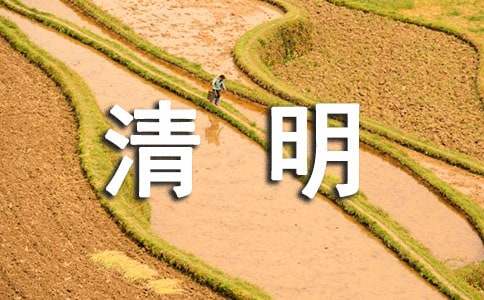清明节英语手抄报内容
制作清明节英语手抄报内容是制作一份清明节英语手抄报的关键所在,以下是清明节英语手抄报内容及图片,欢迎阅读!

清明节英语手抄报内容一:清明英语知多少
清明节是我国重要的传统节日。从二十四节气上讲,它又是节气之一。它是唯一一个节日和节气并存的日子,可见古人对这一天的重视程度。
清明的具体日期在仲春和暮春之交,大约农历4月4、5、6日之间。此时,天气转暖,大地回春,万物复苏,一片生机盎然,家家门口插柳条,祭扫坟墓和郊外踏青。农谚中也有"清明忙种粟"的说法。
作为中国人,对于这些从小看大的习俗我们当然不会陌生,可如果问你“清明”用英文怎么讲、你就未必知道了吧!
首先我们要清楚的是:作为节日的清明节、和作为节气的清明节,它们的英文说法是不同的。
作为节日的清明节一般翻译为"Tomb Sweeping festival"或者"Tomb-sweeping Day",扫墓节或扫墓日。这个翻译着重强调了清明节的重要习俗“扫墓”。这种说法的好处是,老外一听就能大概明白这个节日的背后含义。
也有人把清明节翻译为"All Souls'Day",这是一种站在对方文化角度考虑做出的翻译。因为"All Souls'Day"在西方是确实存在的节日,一般称为“万灵日”。这是一个宗教节日,在有的教派里甚至不止一天。教会会在这一天为那些去世后无法进入天堂的信徒祈祷,希望他们早日进入天堂。其基本意义和清明节相似,也是祭奠死者的节日。
另外再谈到作为节气的清明,它被译为"Clear and Bright",清洁和明亮。我们也不难发现,这种译法强调的是清明时节的气候状况,和其他节气的翻译出发点一致。比如立夏被译为"Summer begins"、小寒、大寒分别被译为"Slight cold"和"Great cold"。
清明节英语手抄报内容二:清明风俗英语讲
每年的公历四月五日前后为清明节,是二十四节气之一。今年的清明节是4月5日。在二十四个节气中,既是节气又是节日的只有清明。清明节是我国传统节日,也是最重要的祭祀节日。
按照旧的习俗,祭祀(扫墓)时,人们要携带酒食果品、纸钱等物品到墓地,将食物供祭在亲人墓前,再将纸钱焚化,为坟墓培上新土,折几枝嫩绿的新枝插在坟上,然后叩头行礼祭拜,最后吃掉酒食回家。
清明节,又叫踏青节,正是春光明媚草木吐绿的`时节,也正是人们春游的好时候,所以古人有清明踏青,并开展一系列体育活动的的习俗。直到今天,清明节祭拜祖先,悼念已逝的亲人的习俗仍很盛行。
Celebrated two weeks after the vernal equinox(24节气之一的春分), Tomb Sweeping Day is one of the few traditional Chinese holidays that follows the lunar calendar(lunar calendar,意为农历、阴历)--typically falling on April 4, 5, or 6. Its Chinese name "Qing Ming" literally means "Clear Brightness," hinting at its importance as a celebration of Spring. Similar to the spring festivals of other cultures, Tomb Sweeping Day celebrates the rebirth of nature, while marking the beginning of the planting season and other outdoor activities.
Qing Ming Jie in Ancient Times
古代的清明节
In ancient times, people celebrated Qing Ming Jie with dancing, singing, picnics, and kite flying. Colored boiled eggs(原来古代中国的清明节和西方复活节一样有彩蛋……小编只能感叹历史惊人的相似了……) would be broken to symbolize the opening of life. In the capital, the Emperor would plant trees on the palace grounds to celebrate the renewing nature of spring. In the villages, young men and women would court each other.
The Tomb Sweeping Day as Celebrated Today
庆祝春天的清明
With the passing of time, this celebration of life became a day to the honor past ancestors. Following folk religion(folk religion,民间习俗、信仰), the Chinese believed that the spirits of deceased ancestors looked after the family. Sacrifices of food and spirit money could keep them happy, and the family would prosper through good harvests and more children.
Today, Chinese visit their family graves to tend to any underbrush that has grown. Weeds are pulled, and dirt swept away, and the family will set out offerings of food and spirit money(注意纸钱的官方说法啊:spirit money). Unlike the sacrifices at a family's home altar, the offerings at the tomb usually consist of dry, bland food. One theory is that since any number of ghosts rome around a grave area, the less appealing food will be consumed by the ancestors, and not be plundered by strangers.
Honoring Ancestors
祭祖
Honoring ancestors begins with proper positioning of a gravesite and coffin. Experts in feng shui, or geomancy, determine the quality of land by the surrounding aspects of streams, rivers, trees, hills, and so forth. An area that faces south, with groves of pine trees creates the best flow of cosmic energy required to keep ancestors happy. Unfortunately, nowadays, with
While bland food is placed by the tombs on Qing Ming Jie, the Chinese regularly provide scrumptious offerings to their ancestors at altar tables in their homes. The food usually consists of chicken, eggs, or other dishes a deceased ancestor was fond of. Accompanied by rice, the dishes and eating utensils are carefully arranged so as to bring good luck. Sometimes, a family will put burning incense with the offering so as to expedite the transfer of nutritious elements to the ancestors. In some parts ofChina, the food is then eaten by the entire family.
Kites
风筝
Besides the traditions of honoring the dead, people also often fly kits on Tomb Sweeping Day. Kites can come in all kinds of shapes, sizes, and colors. Designs could include frogs, dragonflies, butterflies, crabs, bats, and storks.
【清明节英语手抄报内容】相关文章:
清明节手抄报内容英语04-05
清明节手抄报内容文字04-03
清明节手抄报版内容04-07
清明节手抄报的内容04-01
清明节手抄报内容英文04-01
清明节手抄报内容ppt03-31
清明节手抄报内容大全04-01
清明节手抄报内容资料04-07
清明节手抄报内容图片10-25
清明节学校手抄报内容11-23